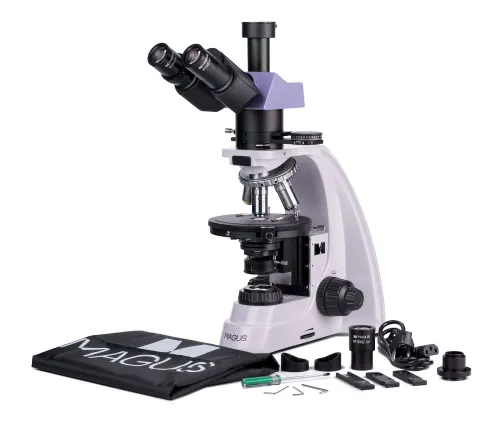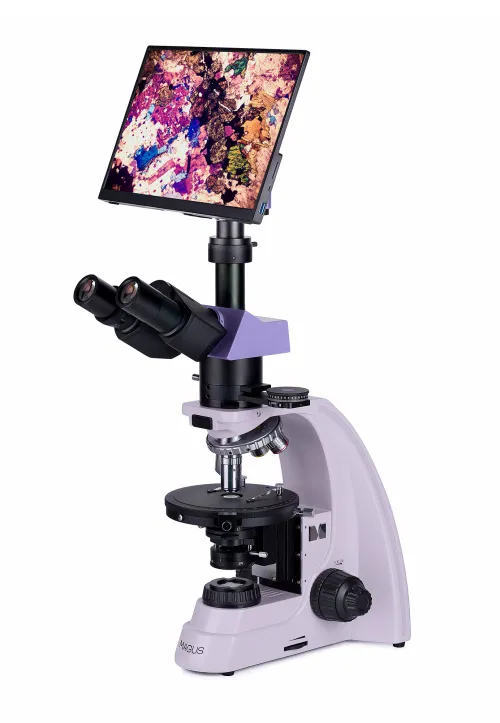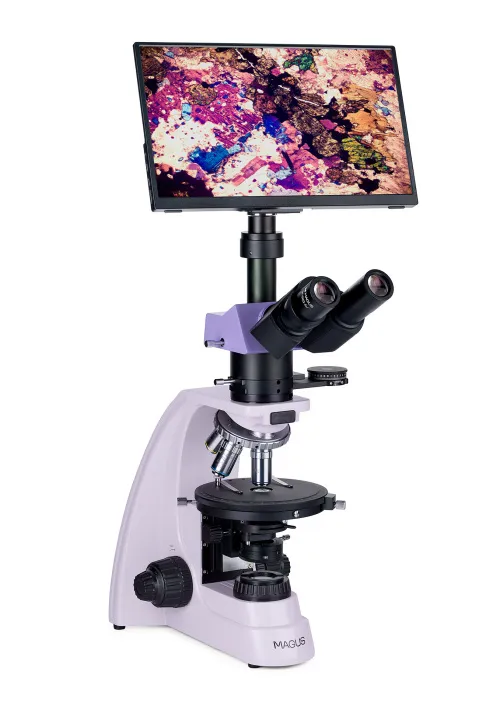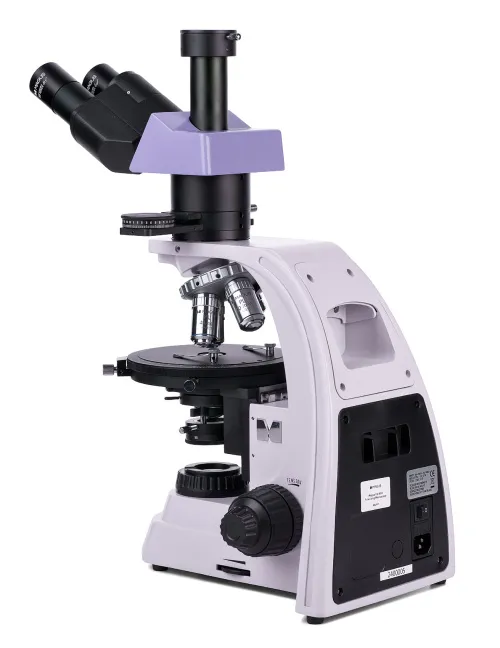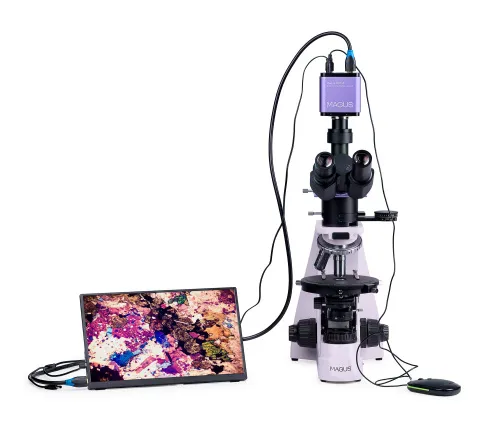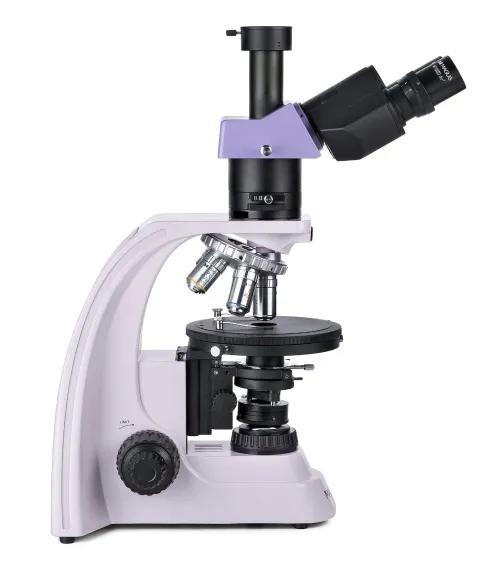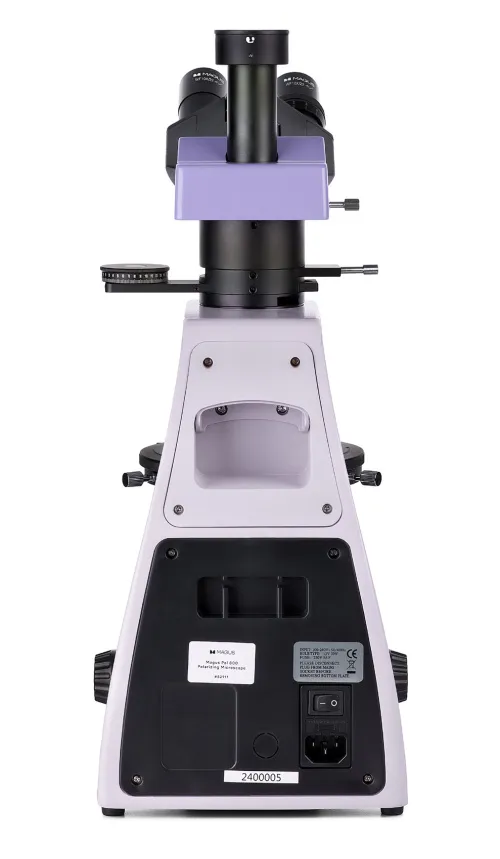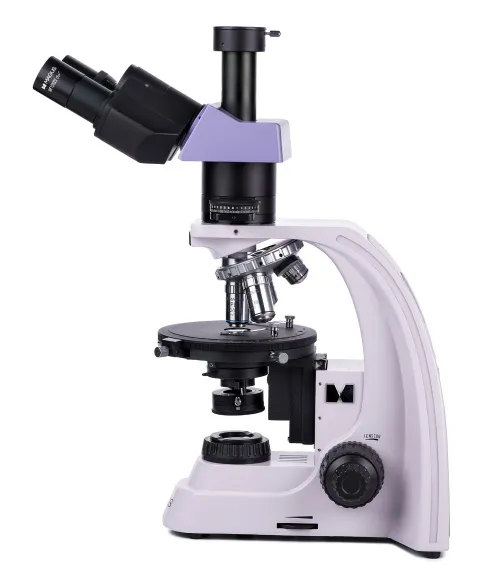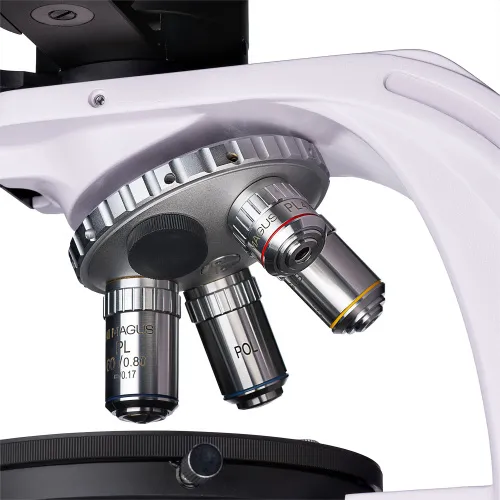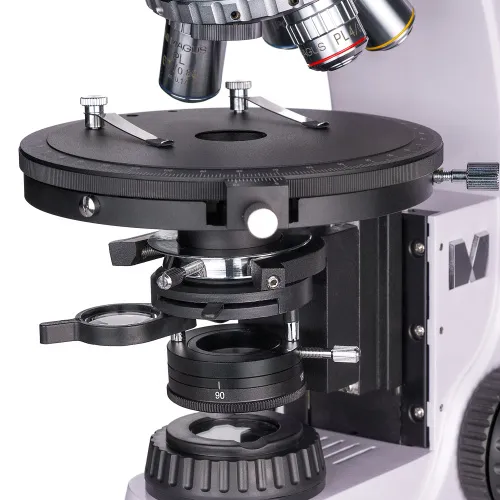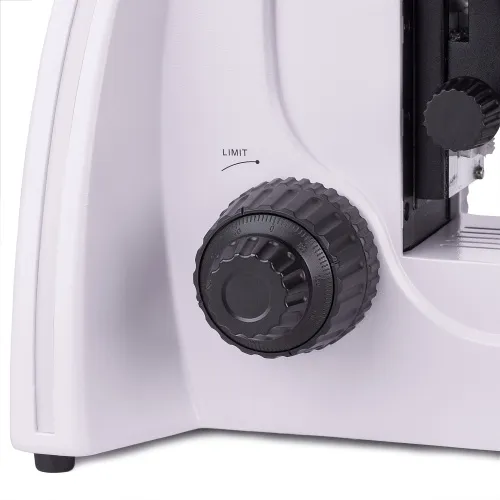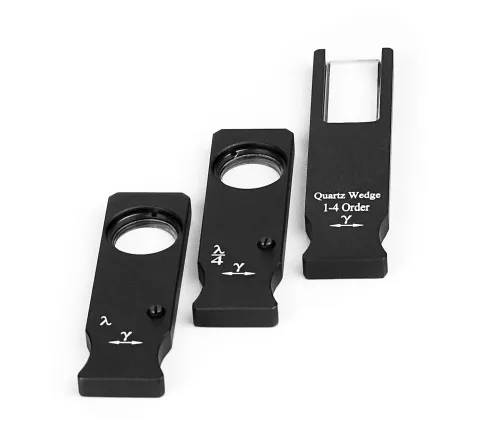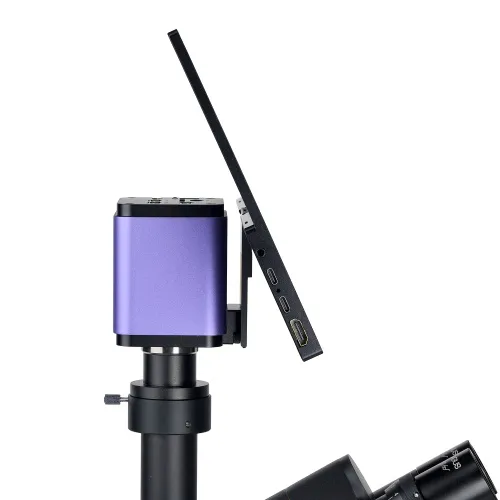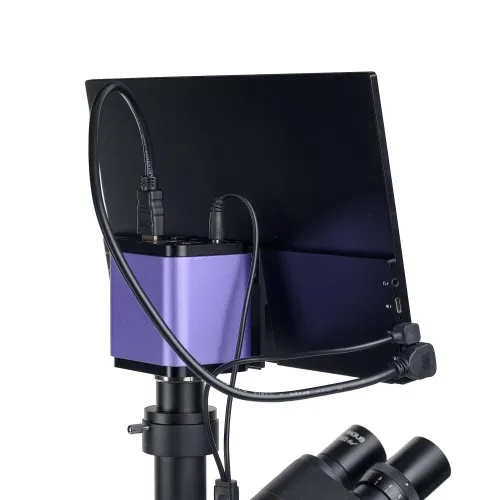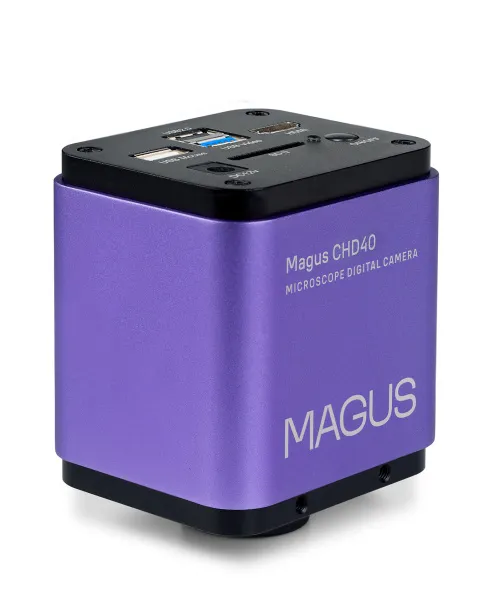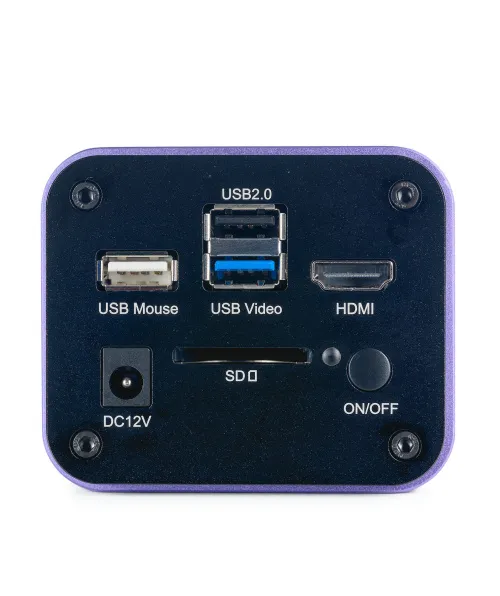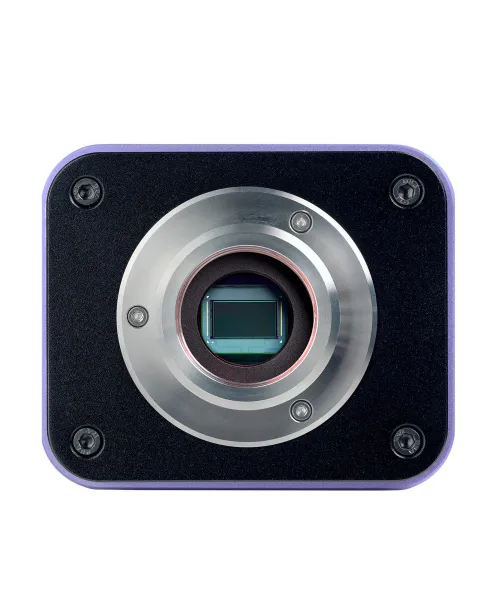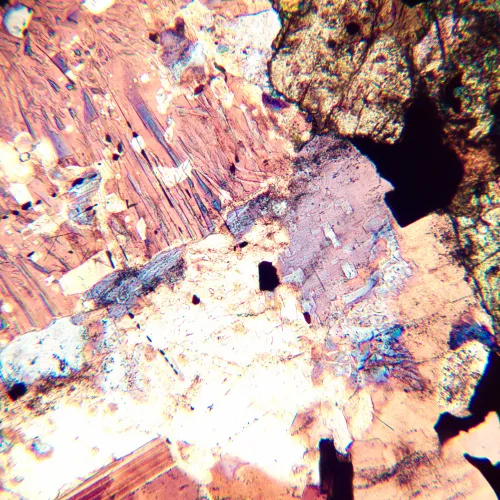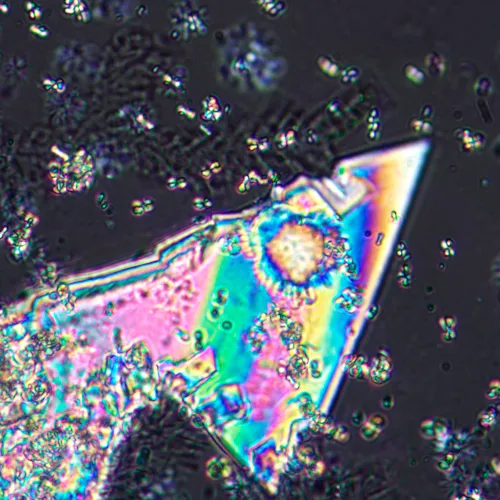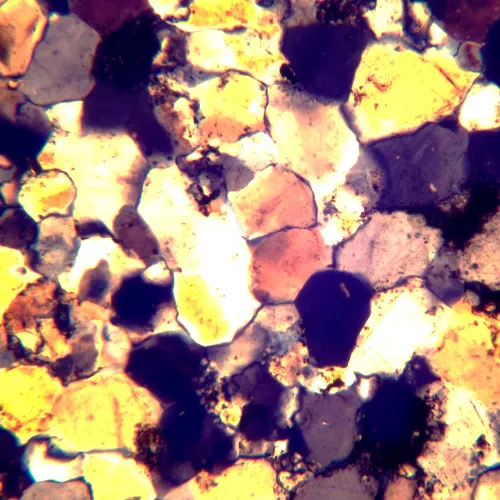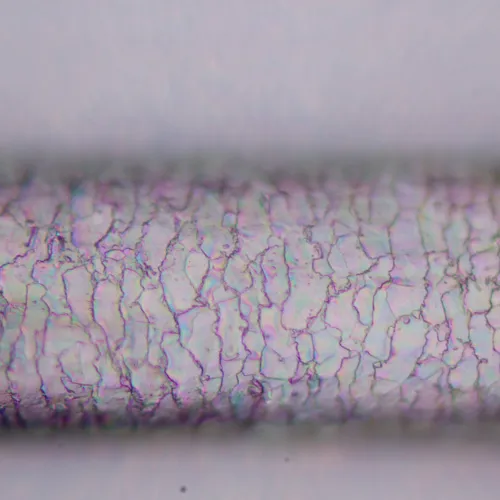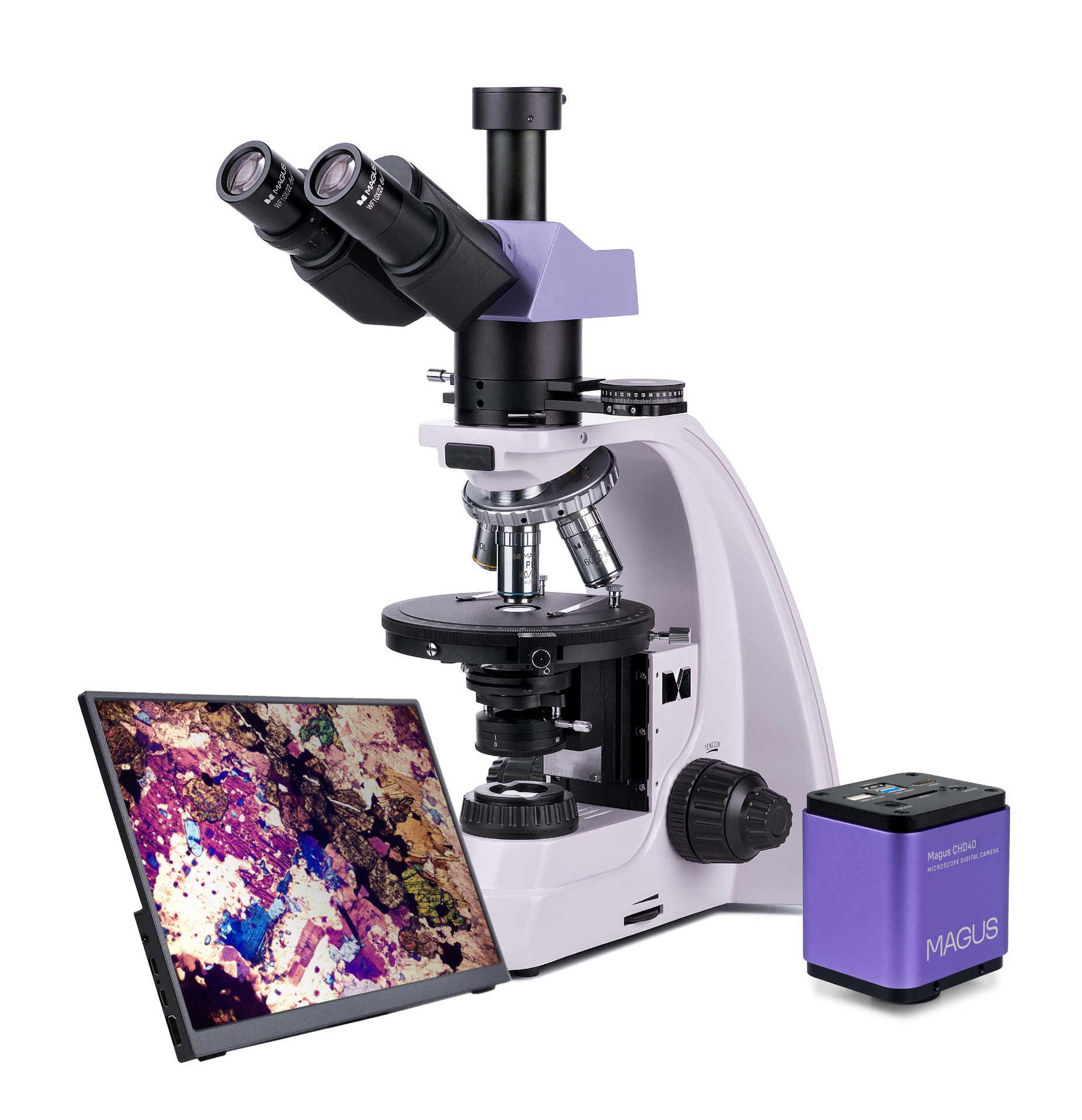MAGUS Pol D800 LCD Polarizing Digital Microscope
With a camera and monitor. Magnification: 40–600x. Trinocular head, plan achromatic objectives. Transmitted light illumination, light source – 30W halogen bulb, Köhler illumination. Bertrand lens and compensators
| Product ID | 83041 |
| Brand | MAGUS |
| Warranty | 5 years |
| EAN | 5905555018522 |
| Package size (LxWxH) | 43x27x63 cm |
| Shipping Weight | 17.25 kg |
The MAGUS Pol 800 Polarizing Microscope is used to study anisotropic objects in polarized and ordinary transmitted light. Objects of study can be biological, geological, or polymer. The optics of the microscope are strain-free, i.e., they do not create parasitic refractions. They form a clear, high-contrast and authentic image. The microscope’s functionality is useful in various fields of science: medicine, forensics, mineralogy, petrography, crystallography, etc.
Digital Camera
MAGUS CHD40 is a digital HDMI camera with three video interfaces and automatic switching between 4K and Full HD depending on the monitor resolution. The camera is equipped with an 8MP sensor and produces realistic images in 4K resolution (3840x2160px) when connected via HDMI or USB3.0. When connected via Wi-Fi, the image quality is Full HD (1920x1080px). The camera uses an HDMI interface to connect to a TV, monitor, or projector directly. In this mode, the camera operates autonomously without a connection to a PC. The HDMI interface provides a high and stable transfer rate from the camera to the external screen. You can connect the camera to a PC via Wi-Fi or USB3.0. Video is recorded at 30fps. The camera combines high FPS and high bandwidth HDMI. Therefore, videos are vivid, with no freezes or gaps between frames. At maximum resolution, the image is well-detailed, moving objects are visible without bugs, and object movement is displayed without delays.
Monitor
The MAGUS MCD40 Monitor is designed to use a visualization system of the MAGUS microscope. It is connected to a camera mounted on the microscope to display real-time images. It supports MAGUS 4K HDMI cameras. The screen diagonal is 13.3 inches. The IPS matrix provides bright images with large viewing angles. If you look at the display at an angle, the color reproduction is not distorted. The display can be placed on a folding stand on a table or shelf or mounted directly to the camera or microscope stand.
Optics
The trinocular head is equipped with a trinocular tube for mounting a digital camera. By using the switch on the body, the light is completely directed either to the eyepiece tubes or to the digital camera. The 30° angle of the eyepiece tubes is comfortable for long-term observations and does not cause strain on the neck muscles. The left tube has a diopter adjustment ring in which it rotates and adapts the optics of the microscope to the user’s unique vision.
The revolving nosepiece is designed for the simultaneous installation of five objectives, with four already included in the package. An additional objective from the MAGUS range of accessories can be purchased separately. All of the objectives are designed to work with 0.17mm thick cover slips. Thanks to the “away from the observer” revolver design, the objective inserted into the optical path is clearly visible during work, which makes the researcher’s work more convenient. The revolver nosepiece slots are centered.
Illumination
The illumination source is located under the object stage, i.e., observations are carried out in transmitted light. The 30W halogen bulb produces bright, eye-friendly illumination that is suitable for use on all objectives. Adjusting the illumination using the Köhler method achieves higher contrast and enhanced image quality.
The microscope is equipped with a polarizer and analyzer. To work in polarized light, the analyzer is introduced into the optical path, and the polarization angle is changed by rotating the polarizer and analyzer relative to each other. The microscope also has an intermediate attachment that holds a Bertrand lens and has a slot for compensators. Compensators enhance the contrast of samples with low birefringence, and the Bertrand lens is designed for conoscopic studies.
Stage and focusing mechanism
The microscope stage rotates and that enables you to quickly change the refraction of light by the sample when working in polarized light. The stage is centered relative to the optical axis of the microscope, has rotation angle gradation and a scale that enables you to determine the angle with an accuracy of 0.1°.
The focusing mechanism provides coarse and fine sharpness adjustment. For coarse focusing, a coarse focusing lock is available, and you can also adjust the coarse tension for the most comfortable control.
Accessories
Optional eyepieces, objectives, digital cameras, and calibration slides are available for the microscope. They broaden the capabilities of the microscope for carrying out researchers’ tasks.
Key features of the microscope:
- Observations in transmitted light in a brightfield and by the polarization methods
- Illumination source is a 30W halogen bulb with a “warm” spectrum of light that is comfortable for the eyes
- Polarization is achieved by a rotating analyzer and polarizer; the intermediate attachment has a Bertrand lens and a slot for compensators
- It is possible to adjust illumination according to the Köhler method, which improves image readability
- The trinocular tube allows for the installation of a digital camera in the trinocular tube
- The infinity plan achromatic objectives are strain-free; the revolving nosepiece slots are centered
- Rotating stage, coarse, and fine focusing
- Compatible with additional accessories: eyepieces, objectives, etc.
Key features of the camera:
- The camera operates autonomously without a connection to a PC and via HDMI interface. Can be connected to a PC via Wi-Fi and a USB3.0 interface
- Auto switching between 4K and Full HD depending on monitor resolution
- 30fps for observing moving objects, recording video, and moving the sample without jerkiness or delays
- SONY Exmor/Starvis color CMOS backlit sensor provides low noise level and high light sensitivity even in low-light conditions. You will get clearer, brighter, and more color-saturated images
- Software with photo, video recording, editing, external display functions, linear and angular measurements
The kit includes:
- MAGUS CHD40 Digital Camera (digital camera, HDMI cable (1.5m), USB3.0 cable (1.5m), USB mouse, 32GB SD memory card, USB Wi-Fi adapter (2pcs.), AC power adapter 12V/1A (Euro), installation CD with drivers and software, user manual and warranty card)
- MAGUS MCD40 LCD Monitor
- Base with a power input, transmitted light source and condenser, focusing mechanism, stage, and revolving nosepiece
- Trinocular head
- Intermediate tube with Bertrand lens, an analyzer, and a compensator slot
- Compensators: λ compensator, λ/4 compensator, quartz wedge
- Infinity plan achromatic objective: PL 4x/0.10 WD 21mm
- Infinity plan achromatic objective: PL 10x/0.25 WD 5.0mm
- Infinity plan achromatic objective: PL 40x/0.65 (spring-loaded) WD 0.66mm
- Infinity plan achromatic objective: PL 60x/0.80 (spring-loaded) WD 0.46mm
- Eyepiece 10x/22mm with long eye relief (2 pcs.)
- 10x/22mm eyepiece with a scale. Scale value: 0.1mm
- C-mount adapter 1x
- Hex key wrench
- Power cord
- Dust cover
- User manual and warranty card
Available on request:
- Eyepiece 10x/22mm with crosshairs
- 12.5x/14mm eyepiece (2 pcs.)
- 15x/15mm eyepiece (2 pcs.)
- 20x/12mm eyepiece (2 pcs.)
- 25x/9mm eyepiece (2 pcs.)
- Infinity plan achromatic objective: PL 5x/0.12 WD 26.1mm
- Infinity plan achromatic objective: PL 20x/0.4 WD 8.8mm
- Infinity plan achromatic objective, fluo: PL 100x/1.25 (spring-loaded, oil) WD 0.36mm
- Infinity plan achromatic objective, fluo: PL 100x/0.8 (spring-loaded, dry) WD 2.02mm
- Mechanical stage attachment
- Calibration slide
| Product ID | 83041 |
| Brand | MAGUS |
| Warranty | 5 years |
| EAN | 5905555018522 |
| Package size (LxWxH) | 43x27x63 cm |
| Shipping Weight | 17.25 kg |
| Type | biological, light/optical, digital |
| Microscope head type | trinocular, digital screen/PC monitor |
| Head | Siedentopf |
| Head inclination angle | 30 ° |
| Magnification, x | 40 — 600 |
| Eyepiece tube diameter, mm | 30 |
| Eyepieces | 10х/22mm, eye relief: 10mm; 10х/22mm with a scale (*optional: 10x/22mm with crosshairs, 12.5x/14; 15x/15; 20x/12; 25x/9) |
| Objectives | infinity plan achromatic, strain-free: PL 4x/0.10; PL 10x/0.25; PL 40x/0.65; PL 60x/0.80 (*optional: PL 5x/0.12; PL 20x/0.4; PL 100x/1.25 (oil); PL 100x/0.8 (dry)); parfocal height 45mm, designed for work with a 0.17mm thick cover slips |
| Revolving nosepiece | for 5 objectives, centering |
| Working distance, mm | 21 (4x); 5.0 (10x); 0.66 (40x); 0.46 (60x); 26.1 (5x); 8.8 (20x); 0.36 (100x (oil)); 2.02 (100x (dry)) |
| Interpupillary distance, mm | 48 — 75 |
| Stage, mm | Ø150 |
| Stage features | 360 ° rotatable, centering, 1° graduation of the rotation angle; a vernier scale for measuring angles with an accuracy of 0.1° |
| Eyepiece diopter adjustment, diopters | ±5 (on the left tube) |
| Condenser | Abbe condenser NA 1.25 with an adjustable aperture diaphragm and a swivel lens |
| Diaphragm | adjustable aperture diaphragm, adjustable iris field diaphragm |
| Focus | coaxial, coarse focusing (21mm, 39.8mm/circle, with a lock knob and tension adjusting knob) and fine focusing (0.002mm) |
| Illumination | halogen |
| Brightness adjustment | ✓ |
| Power supply | 220±22V, 50Hz, AC network |
| Light source type | halogen lamp: 12V/30W |
| Operating temperature range, °C | 5...+35 |
| User level | experienced users, professionals |
| Assembly and installation difficulty level | complicated |
| Polarizer | with 0°, 90°, 180°, 270° marks on the scale; 360° rotatable |
| Intermediate tube | built-in analyzer with rotation 0–360°; a vernier scale for measuring angles with an accuracy of 0.1°; Bertrand lens; slot for installing compensators |
| Compensator | λ compensator; λ/4 compensator; quartz wedge |
| Application | laboratory/medical |
| Illumination location | lower |
| Research method | bright field, polarization |
| Pouch/case/bag in set | dust cover |
| Camera specifications | |
| Sensor | Sony Exmor/Starvis CMOS |
| Color/monochrome | color |
| Megapixels | 8 |
| Maximum resolution, pix | 3840x2160 |
| Sensor size | 1/1.2'' (11.14x6.26mm) |
| Pixel size, μm | 2.9x2.9 |
| Interface connectors | HDMI 1.4, USB 3.0, Wi-Fi |
| Memory card | SD up to 32GB |
| Ability to connect additional equipment | USB mouse, Wi-Fi adapter (USB), flash stick (USB) |
| Light sensitivity | 1028mV with 1/30s |
| Signal/noise ratio | 0.13mV at 1/30s |
| Exposure time | 0.014ms–1000ms |
| Video recording | ✓ |
| Frame rate, fps at resolution | 30@1920x1080 (Wi-Fi), 30@3840x2160 (HDMI), 30@3840x2160 (USB3.0) |
| Place of installation | trinocular tube, eyepiece tube instead of an eyepiece |
| Image format | *.jpg, *.tif |
| Video format | *.h264/*.h265, *.mp4 |
| Spectral range, nm | 380–650 (built-in IR filter) |
| Shutter type | ERS (electronic rolling shutter) |
| Software | HDMI: built-in; USB: MAGUS View |
| System requirements | Windows 8/10/11 (32bit and 64bit), Mac OS X, Linux, up to 2.8GHz Intel Core 2 or higher, minimum 4GB RAM, USB2.0 port, RJ45, 19" or larger display |
| Mount type | C-mount |
| Body | CNC aluminum alloy |
| Camera power supply | DC adapter 12V, 1A |
| Specifications of the AC power adapter | input: AC voltage 100–240V, 50/60Hz, output: DC voltage 12V/1A |
| Camera operating temperature range, °С | -10...+50 |
| Operating humidity range, % | 30 — 80 |
| Monitor specifications | |
| Type of matrix | IPS |
| Display diagonal, inch | 13.3 |
| Display resolution, px | 3840x2160 (4K) |
| Aspect ratio | 16:9 |
| Brightness, cd/m² | 400 |
| Number of displayed colors | 16.7 m |
| Contrast | 1000:1 |
| Horizontal/vertical viewing angle, ° | 178/178 |
| Size of the visible screen area (WxH), mm | 295x165 |
| Pixel pitch (WxH), mm | 0.154x0.154 |
| Frequency of optical source, Hz | 60 |
| Type of matrix backlight | LED |
| LED backlight lifetime, h | 50000 |
| Interface | HDMI |
| Operating temperature range, °C | -15...+55 |
| Operating humidity range, % | 10 — 90 |
| Power supply | AC 110–220V, DC 5–12V/1A (Type-C) |
| Power consumption, W | 12 (max.) |
and downloads
We have gathered answers to the most frequently asked questions to help you sort things out
Find out why studying eyes under a microscope is entertaining; how insects’ and arachnids’ eyes differ and what the best way is to observe such an interesting specimen
Read this review to learn how to observe human hair, what different hair looks like under a microscope and what magnification is required for observations
Learn what a numerical aperture is and how to choose a suitable objective lens for your microscope here
Learn what a spider looks like under microscope, when the best time is to take photos of it, how to study it properly at magnification and more interesting facts about observing insects and arachnids
This review for beginner explorers of the micro world introduces you to the optical, illuminating and mechanical parts of a microscope and their functions
Short article about Paramecium caudatum - a microorganism that is interesting to observe through any microscope


